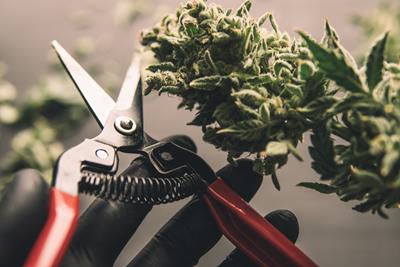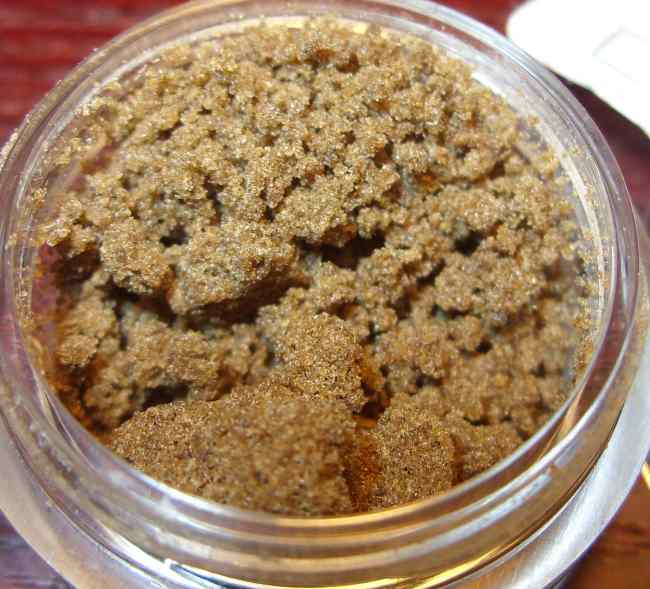
Saturday April 23, 2022
By Trevor Ross
 Education
Education
The broad term for any plant material removed from cannabis buds during the manicuring process is “trim.” Fresh cannabis has small leaves, stems, and other pieces that are less desirable because they have fewer trichomes than the rich, resinous buds. However, fewer doesn’t mean zero. In fact, the small sugar leaves got their name from the faint frosting of trichomes that dust their surface.
Sugar leaves are not included in the final product because they still contain far more chlorophyll and other plant compounds which taste more bitter when smoked, so they are trimmed away. On large or commercial scales, this is done by a cannabis trimming machine, but most home growers just use manicuring scissors.
Once growers know how to trim cannabis, they can reap a hefty stash of this sticky trim that probably shouldn’t be smoked, but certainly shouldn’t be wasted. Thankfully, there are ways to use trim, particularly by extracting it for edibles and bubble hash.
This article reviews uses for marijuana trim, including how to make edibles, and tips for how to make bubble hash.
Edibles
THC is not water-soluble like salt or Kool-Aid, but is instead fat-soluble, meaning it dissolves in fats, including oils and butter. It is also alcohol-soluble, and so can be infused into alcoholic ingredients for some potent cocktails or easy tinctures. However, before either of these can be done, the cannabis must be decarboxylated, or “decarbed.”
Decarboxylation

THC, the psychoactive ingredient in cannabis, begins as THCA. Under a microscope, the “A” in THCA is a supplementary carboxylic acid group which must be removed with heat to result in psychoactive THC. Usually this is done when flame touches the flower, but when cooking with cannabis it’s generally done in the oven, or sometimes directly into the oil being infused. The surest way to achieve this is with an oven.
Preheat the oven anywhere between 225-240° F. Lower temperatures will preserve more terpenes, but require longer in the oven. Begin by covering a baking sheet with foil or parchment. Spread the trim evenly across the baking sheet. Bake for anywhere between 25-40 minutes. Higher temperatures will require less time.
The cannabis trim should emerge toasted brown and crispy, but not burned.
Infusing Trim in Oil and Butter

In a saucepan, bring your oil of choice to a low simmer and add the trim. If the trim is already decarbed, it only needs to simmer for about 30 minutes. During this time, the cannabinoids will separate from the withering plant material and bind to the lipids in the oil. If the trim has not been decarbed yet, then it should simmer for up to three hours. In both cases, stir frequently and make sure the temperature does not rise too high.
Butter infusions must take place at an even lower temperature to avoid scorching the butter. A double-boiler setup is strongly recommended for butter infusions.
Strain the final mixture through a cheesecloth or fine mesh colander and discard the used trim. The resulting oil or butter can be used to replace regular oil or butter in any recipe!
Infusing Trim in Alcohol

Decarboxylated trim can be infused into alcohol a couple different ways—both via heat in a double boiler over 2-3 hours, or soaked at room temperature for 1-2 weeks. If you choose to cook it, be careful not to let the temperature of the alcohol exceed about 160° F, or else it begins to evaporate. Soaking it at room temperature is the slower but safer option.
If you choose to soak it, add the trim to a high-proof alcohol like Everclear or vodka and store in a cool, dark place for 1-2 weeks, shaking at least once per day. The starting ratio for infusing alcohol with cannabis is 1/8 oz. of cannabis to 750ml of alcohol. From there, consumers can decide how mild or wild they prefer.
Some have reported a quick three-day infusion by this method, but longer is always better, especially if using a lower-proof alcohol.
Bubble Hash

Bubble hash, or ice water hash, is similar to the kief that falls to the bottom of most grinders. Instead of a “dry sift,” bubble hash is extracted in ice water, and sifted through a series of fine mesh screens which filter valuable trichomes from the remaining plant material.
Making bubble hash at home does require some unique equipment, most notably the bags, which can be purchased online, and usually a five-gallon bucket.
Once the bags are properly layered in the bucket, fill it with ice water and add your trim and any other remaining cannabis byproduct. Freezing the trim beforehand will help make it brittle and easier to break apart. Churn the mixture with a paddle, or give your wrist a break by attaching a paint-mixing bit to an electric drill. In either case, remember you’re only knocking the plant material around to break those trichomes loose, not blending a smoothie.
Churn the mixture for about 15 minutes, then let it settle for another 20-30 minutes. Lift out the first bag with all the ice and plant material and set it aside for the moment. The remaining bags are then removed one at a time and the screens at the bottom of each are scraped clean of the resulting hash. The hash will get purer with each bag as more plant material is filtered out. This process can be repeated with the initial plant material until it yields no more hash.
Bubble hash gets its name from its tendency to bubble when smoked, as remaining pockets of air and water are released. It can be smoked as-is, sprinkled over joints or bowls, or vaporized from a dab rig.
Conclusion
Harvesting and trimming cannabis are as important as any step in the growing process. Any commercial grower will attest that throwing away trim is like throwing away money. Using trim is essential to growers trying to maximize yield profit.
All of these methods work as well or better with regular cannabis buds in that full buds will deliver more cannabinoids into whatever product you’re making, but these options are especially effective for squeezing every last gram out of your harvest.
Frequently Asked Questions
How Long Does It Take For Cannabis To Grow Completely?
Growing cannabis can take anywhere from 4-8 months depending on the strain and growing conditions. Then another 1-2 months of curing is recommended for a top-shelf product. However, some auto-flowering plants can be harvested in as few as 10 weeks.
How Do You Make Dabs Out of Trimmings?
The best way to extract homemade concentrate is by making bubble hash. Most cannabis oils and concentrates are extracted by expensive and potentially dangerous closed-loop extractors that use solvents, but bubble hash can be extracted at home with a 5-gallon bucket, ice water, and a series of bubble bags.
How do you use your trim? Tell us in the comments below!
Photo Credit: Shutterstock







